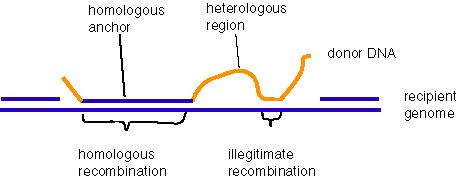Genetics
Homology-facilitated illegitimate recombination
The process of branch migration frequently stops when it encounters the end of homology between the recombining molecules. Interestingly, neighboring heterologous are sometimes integrated. We termed the underlying process "homology-facilitated illegitimate recombination" (HFIR) to indicate the essential role of homologous anchor sequences (see Figure). HFIR has been shown to mediate the transfer of genes from transgenic tobacco plastids (trnL und ycf5) to Acinetobacter sp. equipped with a truncated aadA gene.

The molecular model: Homologous recombination within the anchor sequence couples the donor and recipient DNA. This strongly increases the probability for an illegitimate recombination event that leads to the integration of a heterologous DNA segment.
Publications:
- de Vries, J., Herzfeld, T., Wackernagel, W. (2004) Transfer of plastid DNA from tobacco to the soil bacterium Acinetobacter sp. by natural transformation. Mol Microbiol 53: 323-334.
[Abstract] [Reprint] - de Vries, J., Wackernagel, W. (2002) Integration of foreign DNA during natural transformation of Acinetobacter sp. by homology-facilitated illegitimate recombination. Proc Natl Acad Sci USA 99: 2094-2099.
[Abstract] [PDF] [Full text] [Reprint]
Back | Other articles by de Vries